The wolverine state is a nature lover’s dream with its unspoiled nature, like the country’s longest freshwater coastline, golden beaches, massive lakes that feel like oceans, and an abundance of farms with delicious fresh fruit. But the state of Michigan isn’t exactly known for its hot weather. However, while short, this state does experience summer, but some places get hotter than others. So, where is the hottest place in Michigan?
Hottest Place In Michigan
The hottest place in Michigan is the city of Niles in Berrien and Cass counties. Its warm season lasts around three and a half months, from May to September. During this period, the average temperature is approximately 71°F. However, during July, the hottest month, the temperature averages around 81°F. But, while this city experiences a hot summer, its winters are cold, with an average temperature of 42°F and 20°F during the coldest month.
Niles sits on the St. Joseph River and is surrounded by Niles Township, rolling hills, and steep river banks. Furthermore, the area has numerous farms because of the rich and fertile soil. Lastly, this city boasts a population of 11,761 as of 2021.

A historic home in Niles, Michigan.
©FotoGuy 49057 / CC BY 2.0 – License
The Hottest Temperature Ever Recorded in Michigan
Michigan recorded its hottest temperature ever during the heat wave of 1936, which occurred between July 8th and July 14th. Unfortunately, during this period, the state experienced one of the worst heat waves ever recorded in the USA’s history. Before the summer of 1936, Detroit had only experienced seven days that exceeded 100 degrees in its entire history. However, that number doubled during the heat wave when the city experienced a week of temperatures over 100 degrees. However, Mio Michigan was hit badly, with the hottest day reaching 112 degrees Fahrenheit, which is the highest temperature ever recorded in Michigan. Unfortunately, this heat wave caused numerous deaths. For example, 364 people lost their lives in Detroit alone. Sadly, infants and the elderly made up most of these numbers. However, 570 of Michigan’s residents died during the heat wave, and 5000 people nationwide.
The History Of Niles
The city of Niles is located in Berrien County in southwest Michigan. What makes this city so interesting is that it is the only locality in the state that was under the control of Great Britain, France, Spain, and the USA. Furthermore, it became a stop between Detroit and Chicago on the Sauk Trail. Niles was permanently settled in 1828 when it was named after Hezekiah Niles, an American editor. Furthermore, Niles developed as a hub for the St. Joseph River Valley produce. As a result, the city housed many manufacturers, like industrial and assembly-line equipment, paper products, commercial refrigerators, and wire.
Ecology And Wildlife
There is plenty of scenery and nature to enjoy around the hottest place in Michigan. Thanks to the rolling hills and St. Joseph River, wildlife is abundant in the area, including:
Great Blue Heron
The Great blue heron is a common resident of Michigan. While they occur throughout the state, they are primarily found in the Upper Peninsula or southern half of the Wolverine State.
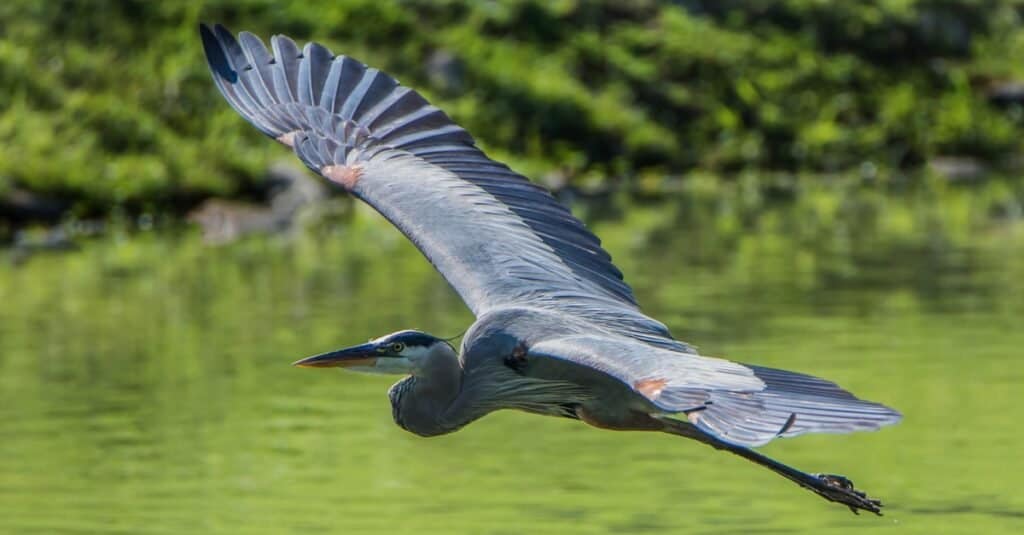
Great blue herons aren’t fussy and will eat anything that comes into striking distance of their long beaks.
©Tom Franks/Shutterstock.com
Bald Eagle
The bald eagle occurs throughout the year in Michigan. In fact, bird watchers for the state record them on 6% of summer checklists and 9% of winter checklists. These birds of prey are widely-recognized thanks to their white head, large hooked yellow bill, and yellow eyes.

Bald Eagles are large birds of prey with a white head and tail and a dark brown body and wings.
©Jack Molan/Shutterstock.com
Striped Skunk
There are three types of skunks in the USA, spotted, striped, and hognose. However, the most common species in Michigan is the striped skunk, which occurs throughout the US except for Alaska. These little critters can be solid white, solid black, or a combination of both.
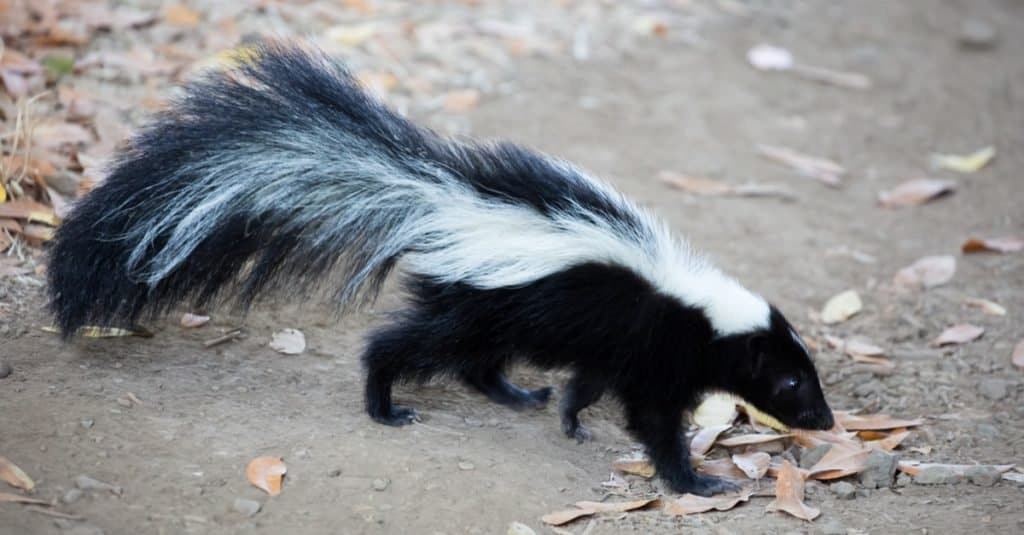
The striped skunk varies in size depending on their location and time of year. For example, their weight ranges from 1.5 to 13 pounds.
©yhelfman/Shutterstock.com
Gray Fox
There are two types of foxes in Michigan, the gray and red fox. The gray fox is very adaptable and can survive in various habitats. They are short than red foxes but are more territorial and aggressive. In addition, they are often confused with red foxes because of the reddish tufts of fur around the ears and neck.

Grey foxes are the only dog family members that can climb trees. They will do this when searching for prey, escaping from predators, or sleeping.
©iStock.com/johnpane
Red Fox
While red foxes can also inhabit various environments, they tend to prefer grasslands. They have reddish-brown coats with long bushy tails. However, their tails aren’t just there to be aesthetically pleasing; they help the foxes balance, much like a cat.
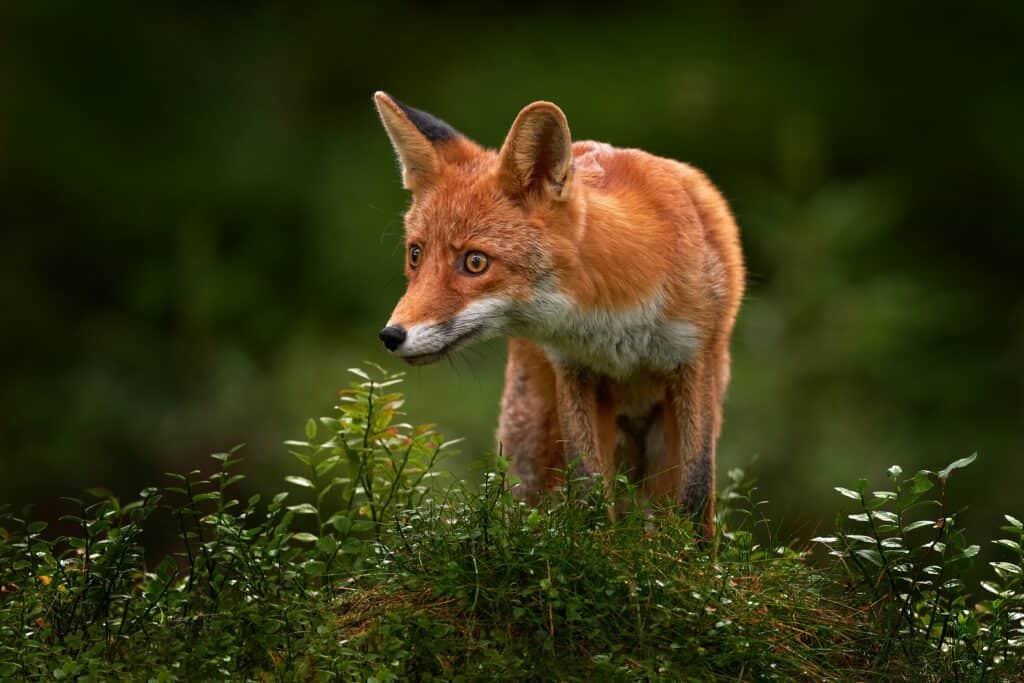
Red foxes are fast runners and can reach speeds of 31 mph. In addition, they can jump over six feet high.
©Ondrej Prosicky/Shutterstock.com
Coyote
The coyote is a staple in the Wolverine State and is found in every county. But unfortunately, these clever animals are increasingly encroaching on urban and suburban areas throughout Michigan. This is due to humans destroying their natural habitats. However, coyotes are stealthy and can adapt to most situations without detection.
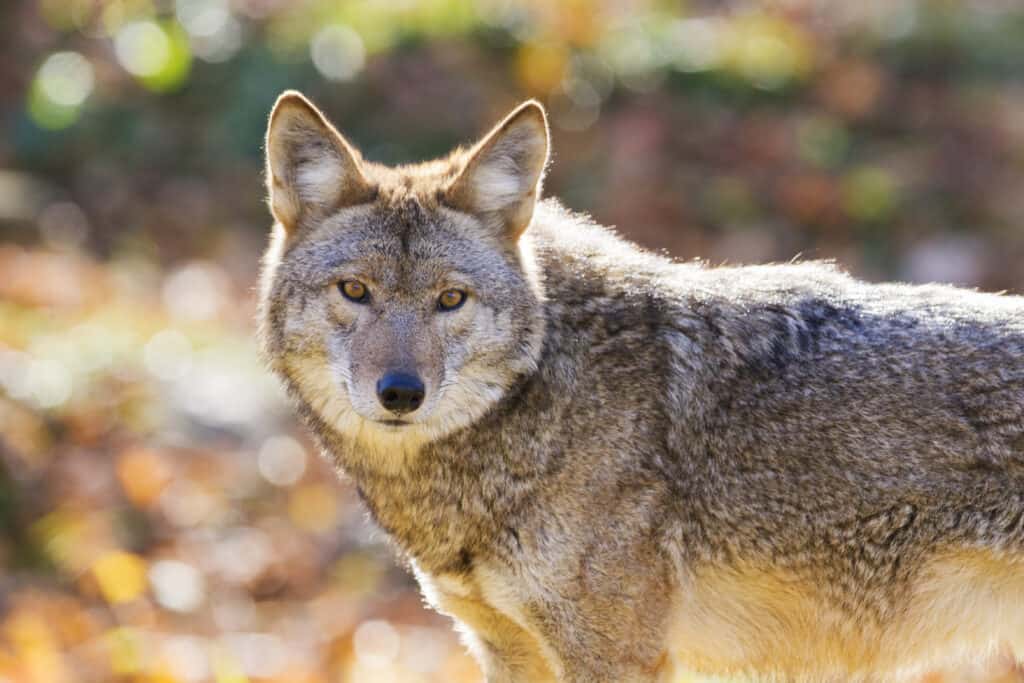
Coyotes have a varied diet and eat both meat and plants, making them omnivores.
©Mircea Costina/Shutterstock.com
North American River Otter
The North American river otter inhabits any area with a permanent food supply and an available water source. In addition, they live in coastal marine and freshwater habitats, including lakes, rivers, swamps, marshes, and estuaries. These adorable critters can survive in environments like warm and cold latitudes and high elevations. However, they tend to be sensitive to pollution and will desert areas with water pollution.
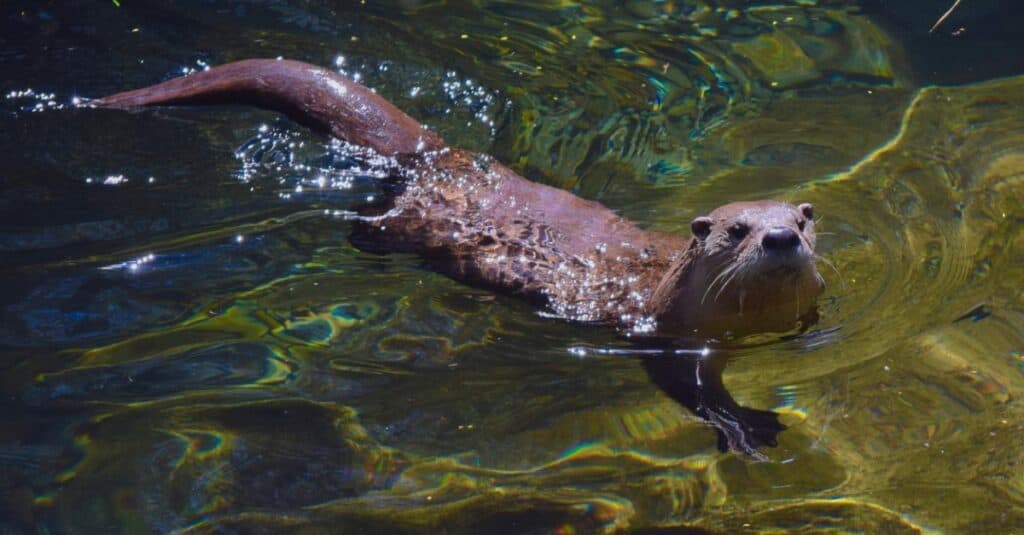
Northern river otters are mammals that are related to minks, weasels, stoats, wolverines, and badgers.
©iStock.com/Kathryn Farley
Smooth Green Snake
The smooth green snake is the only species of snake in the Wolverine State that is bright green. However, some variations are tan or light brown in color. They are medium-sized snakes that can grow 12 to 26 inches long. These green snakes usually occur in wet, grassy habitats, like savannas, prairies, meadows, pastures, old fields, vacant lots, roadsides, marshes, stream borders, and the edges of lakes. Furthermore, they also inhabit the edges of pine forests. Additionally, they bask, forage, or hide in or beneath logs, stumps, low shrubs, woody debris, rocks, boards, or concrete. During the colder months, these snakes will overwinter in small mammal burrows or abandoned ant hills.
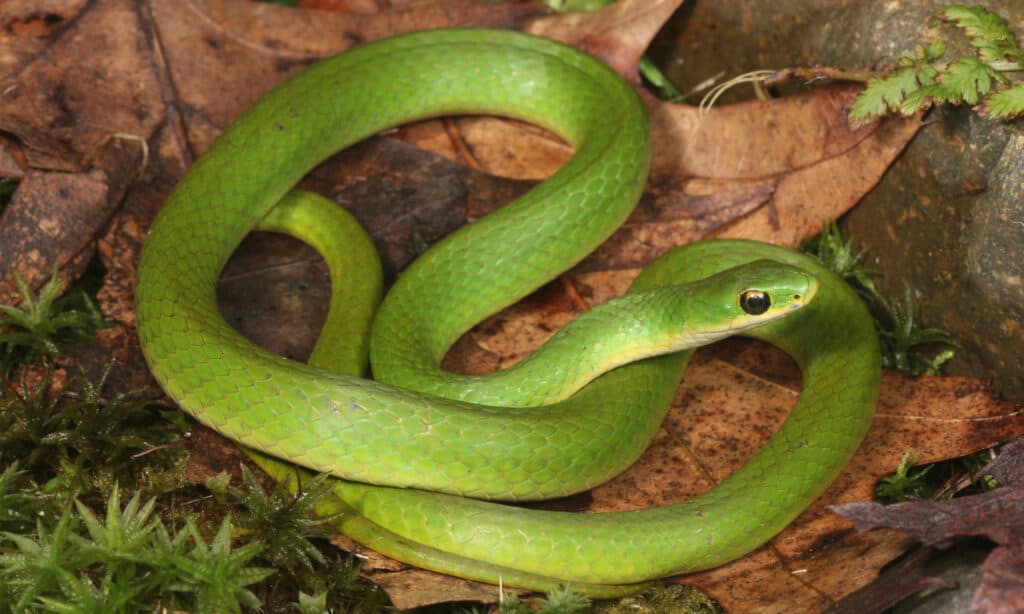
Smooth green snakes are medium in size and can grow 12 to 26 inches long.
©iStock.com/tamers1
Queen Snake
The Queen snake is a slender small-headed snake that comes in olive, brown, or gray with a light stripe on either side of its body. These snakes range in size from 13.4 to 36.3 inches. Queen snakes need moving water to survive and usually occur along overhanging shrubs and aquatic plants or against or under rocks at the shore’s edge. However, their preferred habitat is shallow streams with trees and shrubs nearby. Furthermore, they are also found along the edges of marshes, ponds, ditches, lakes, and canals. In fact, they can thrive in any area with an abundance of crayfish. When queen snakes feel threatened, they dive into the water and hide at the bottom or swim along the edge briefly before re-emerging. These lakes are diurnal but spend most of the day hiding under woody debris or flat rocks on the shoreline.
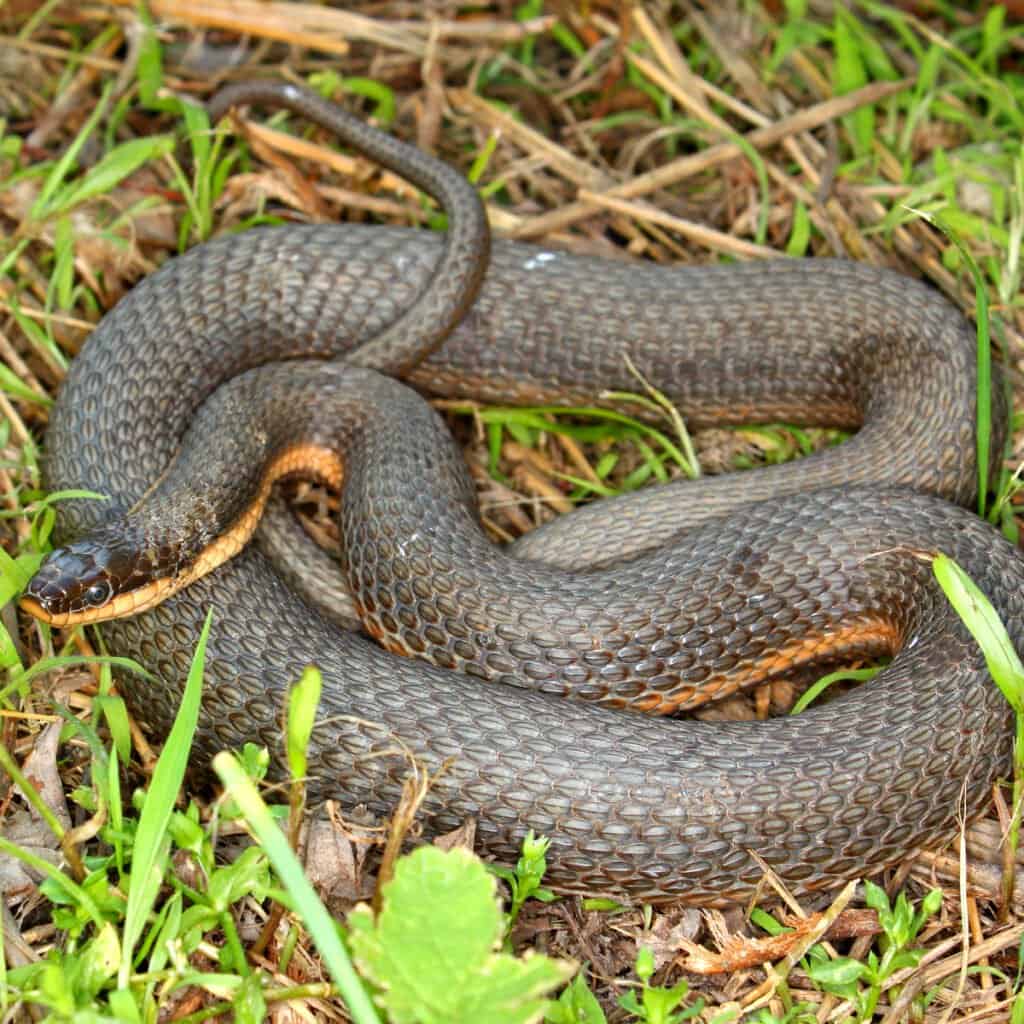
Queen snakes need moving water to survive and usually occur along overhanging shrubs and aquatic plants or against or under rocks at the shore’s edge.
©Jason Patrick Ross/Shutterstock.com
Things To Do In Niles
There is plenty of things to do in the hottest place in Michigan, including:
- Lehman’s orchards
- Fort St, Joseph Museum
- The Lavender Hill
- Madeline Bertrand County Park
- Saint Joseph River Park
- Fernwood Botanical Garden and Nature Preserve
- Niles Scream Park
Where is Niles, Michigan Located on a Map?
Niles is a city neatly tucked away in the city of Berrien and Cass counties. It is located near the Indiana state line in the city of South Bend. It is also the hottest city in Michigan. In 2010, the population was close to 12,000 people.
Here is Niles, Michigan on a map:
The photo featured at the top of this post is © Bennian/Shutterstock.com
Thank you for reading! Have some feedback for us? Contact the AZ Animals editorial team.






